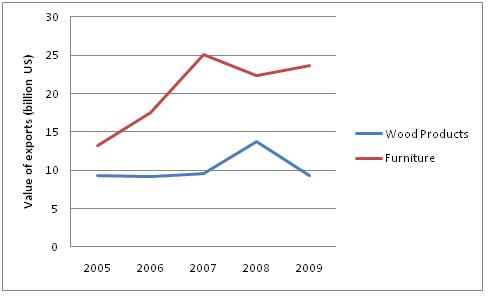The process of establishing the Central American-Dominican Republic Free Trade Agreement (CAFTA-DR) began in 2006 in El Salvador, Guatemala, Honduras and Nicaragua, Dominican Republic in 2007, and in Costa Rica in 2009. This region is the 14th largest export market for U.S. products (USEAC 2011). CAFTA-DR will phase out tariffs between the U.S. and Central American countries within 15-20 years (USDA FAS 2009). Some tariffs were immediately duty free after the trade agreement took effect (USDA FAS 2009). The trade agreements help to expand market opportunities and allow companies to compete in the global market (USEAC 2011). From 2006 to 2008, the export of wood products from the Appalachian region to Central America increased by 51% (Figure 1). Furniture exports to Central American increased by 43% from 2006 to 2007(Figure 1). The rise in exports from the Appalachian region to Central America may be a result of the establishment of CAFTA-DR. Due to unstable financial markets, tighter credit limits, and increase freight rates global exports of Appalachian wood products and furniture decreased in recent years (Figure 1; VDACS 2008). To increase sales the Appalachian region needs to increase product competiveness by expanding export markets and improving product promotion (Wang et al. 2010).

The CAFTA-DR may help increase exports of wood products from the Appalachian region. A 1996 study on the North American Free Trade Agreement (NAFTA), Prestemon (1996) found that lumber and plywood were to gain the most from free trade out of all wood products being exported. Hardwood lumber exports were expected to increase from 45-120% as a result of NAFTA (Prestemon 1998). It is important for Appalachian forest products companies to identify Central America as a potential export market.
Companies from the Appalachian region new to exporting must have their products categorized by the Harmonized System (HS), which is required by customs authorities. To receive a product duty rate, companies must provide the product number required by the importing country or a “Schedule B number” assigned by the U.S. International Trade Commission. This number is required to determine if the product qualifies under the Free Trade Agreement. These numbers can be obtained from the Schedule B Search Engine on the U.S. Census Bureau’s website (USEAC 2011).
Appalachian forest products companies looking to expand their markets into Central America should contact the U.S. Commercial Service in Central America. This service helps companies conduct successful business in Central America by providing promotion of products and services and protection of U.S. business interests overseas (USCSCA 2011).
Literature Cited
- Prestemon, J. P. and J. Buongiomo. 1996. Effects of the North American Free Trade Agreement on Mexico’s imports of forest products from the United States and Canada. Canadian Journal of Forest Research. 26:794-809.
- Prestemon, J. 1998. The Effects of NAFTA and FTAA on U.S. Exports of Hardwood Forest Products. Hardwood Symposium Proceedings. May 6-9, 1998.
- U.S. Commercial Service Central America (USCSCA). 2011. Access 4/1/2011 Available at www.buyusa.gov.centralamerica/en/offices.html
- U.S. Department of Agriculture Foreign Agricultural Service (USDA FAS). 2009. International Agricultural Trade Report. CAFTA-DR Free Trade Agreement Early Assessment of the Agreement. October 25, 2009.
- U.S. Department of Commerce (USDC). 2010. Trade Stats Express. Available at: http://tse.export.gov/TSE/TSEHome.aspx
- U.S. Export Assistance Center (USEAC). 2011. Accessed 4/1/2011. Available at www.export.gov.
- Virginia Department of Agriculture and Consumer Services (VDACS), 2008. Virginia Forest Products Export News. Fall-Winter 2008. Available at: http://www.vdacs.virginia.gov/international/pdf/forestnews.pdf
- Wang, J., J.P. Armstrong, J.Wu, W. Lin. 2010. An analysis of Appalachian hardwood products in the Chinese Market. Wood Fiber Science. 42(1): 71-80.
